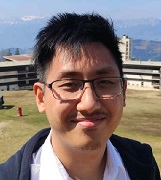Keywords:
2D materials, Dichalcogenides, Sulfurization
cliquer pour voir la liste des membres du jury/clic here for the jury members
Abstract
Two-dimensional semiconducting metal dichalcogenides (TMDs) such as MoS2 and WS2 are potential candidates for More-than-Moore technologies (chemical sensors, photodetectors, memories, RF devices, etc.), thanks to their highly anisotropic and tunable optoelectronic properties, and good chemical robustness. However, their synthesis requires high temperatures (> 850 °C), hindering a direct implementation on silicon-based integrated circuits (collapsing above 450-500°C). In this thesis work, two approaches based on sulfurization of metal or metal oxides have been implemented in order to realize different types of lamellar metal sulfides including WS2, SnS2 and SnS at low temperatures. The first approach was based on the use of nickel as a crystallization promoter for the synthesis of ultra-thin WS2 layers via the sulfurization of Ni/W thin films using an organosulfur precursor: the 1,2-ethanedithiol. This approach successfully afforded highly crystalline and (001)-oriented WS2 layers at temperatures as low as 650 °C whereas without Ni, higher temperature (above 850 °C) would have been necessary to obtain a similar crystallinity. The second approach consisted in the synthesis of SnS2, a post-transition metal disulfide sharing similar structural and physicochemical properties with MoS2 and WS2, but crystallizing at much lower temperature. Starting from ultrathin ALD-deposited SnO2 layers, highly crystalline (001)-oriented SnS2 and SnS films were selectively obtained by organosulfur-mediated sulfurization using either t-butyl disulfide (for SnS2) or t-butylthiol (for SnS) at temperatures as low as 350 °C. For both approaches, thorough physicochemical characterization are provided, and the conversion mechanisms are discussed.
Membres du jury/ Jury members :
|
Dr. |
N.Schneider |
Institut Photovoltaïque d’Ile-de-France, Palaiseau (France) |
Rapporteure |
|
Dr. |
N.Bahlawane |
Luxembourg Institute of Science and Technology: Esch-sur-Alzette (Luxembourg) |
Rapporteur |
|
Dr. |
C.Marichy |
Laboratoire des Multimatériaux et Interfaces (LMI), CNRS, Université Claude Bernard Lyon 1, Villeurbanne (France) |
Examinatrice |
|
Prof. |
C.Vallée |
Laboratory of Microelectronics (LTM), CNRS, Grenoble (France) |
Examinateur |
|
Dr. |
D.Muñoz-Rojas |
Laboratoire des Matériaux et du Génie Physique (LMGP), CNRS, Grenoble INP Minatec, Grenoble (France) |
Examinateur |
|
Dr. |
J.Coraux |
Institut Néel, CNRS, Grenoble (France) |
Examinateur |
|
Prof. |
H.Renevier |
Laboratoire des Matériaux et du Génie Physique (LMGP), CNRS, Grenoble INP Minatec, Grenoble (France) |
Thesis Director |
|
Dr. |
S.Cadot |
CEA-LETI, Grenoble (France) |
Thesis Co-director |
Maison MINATEC
3 Parvis Louis Néel Grenoble
Accès : TRAM B arrêt Cité internationale
Free entrance - No registration



